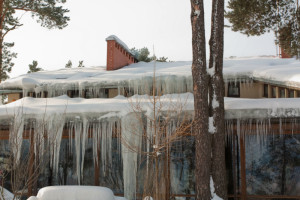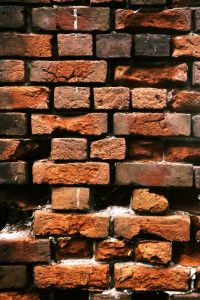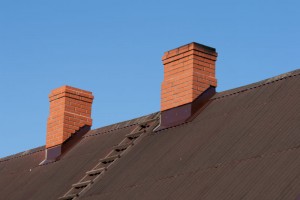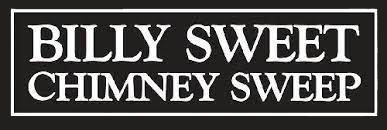by Billy Sweet | Nov 28, 2015 | Freeze Thaw Cycle
You’re likely familiar with the damage the freeze-thaw cycle can do to the roadways; it’s what causes pot holes to appear each year! Water makes its way into the tiny cracks in concrete, asphalt, or stone. When the temperature drops, that water freezes and expands, causing the concrete, asphalt, or stone to crack or crumble. If you have a home with a masonry chimney, you should be aware that the freeze-thaw cycle can cause the same damage to your chimney’s bricks, concrete, and mortar.

Water damage and your chimney
Water can cause many problems with your chimney. The freeze-thaw cycle can cause the mortar between your chimney to crumble; it can cause parts of your brick to flake off, which is referred to as spalling; and it can cause your chimney crown to crack and crumble. Over time, if water damage goes unaddressed, it can mean major problems for your chimney. Your chimney’s overall structure can fail, causing it to lean and become unsafe. A damaged chimney also will let water into the rest of your home, leading to water stains on your ceiling and walls, rotting wood on adjacent structures, collapsed hearth support, a damaged firebox, rusted fireplace accessories, and failing hearth structure.
Repairing water damage
The first step in repairing water damage is to find that damage. This is one reason your annual chimney inspection is so important. Your certified chimney technician can find signs of damage early, so that it can be repaired before minor water damage becomes major water damage. In many cases, it will take the work of expert masons, like those at Billy Sweet Chimney Sweep to repair your chimney’s water damage. We provide services such as tuckpointing, chimney crown repair and replacement, and removing and replacing spalling bricks.
Preventing water damage
When it comes to water damage and your chimney, an ounce of prevention is worth a pound of cure! Taking steps to prevent chimney damage now can save you from costly repairs later. Having a chimney cap installed atop your flue can help keep water from running down the interior walls of your chimney. Repairing a damaged chimney crown will keep water from running down the exterior sides of your chimney. It’s important to make sure the flashing around your chimney is secure, and if your chimney is located on a part of your roof that experiences a lot of rainwater or snow, a cricket — a tent-shaped piece of metal — can be installed to divert water away from the chimney. There also are waterproofing sealants that can be applied to your chimney. Those sealants keep water from seeping into your chimney’s masonry while still allowing your chimney to expel the gases created by your fires.
Ultimately, the key to protecting your chimney from water damage is working with your certified chimney sweep to make sure that any problems are caught and addressed early before you have major chimney damage. If you’re overdue for an inspection, or if you’ve noticed cracking masonry on your chimney, call the experts at Billy Sweet today. We also can talk to you about waterproofing applications to protect your chimney.
by Billy Sweet | Jul 26, 2015 | Winter Masonry Damage
As summer begins to quickly fade away, it’s time now to bring attention to your chimney before winter is upon us. Among all the repairs and other activities associated with the warmer summer months, it is hard to think about preparing the upcoming winter. That feeling is completely understandable! However, there are a few reasons why you should focus some attention on your chimney at this time of the year.

Why should I have to get it repaired?
Your chimney, built in the masonry style, is built of porous materials such as concrete, brick, mortar, and stone. Think of it similar to a sponge in the way they hold water. Though they appear to stand the test of time, without proper care they can begin to crack as the processes of freezing and thawing expands, and then contracts, the masonry. Over time this leads to bricks loosening, and eventually the entire chimney will collapse. As you can tell, winter can be very hard on your chimney. With the addition of intense use of your fireplace during those months, it can amass a variety of problems… that are then ignored over the summer months as it goes unused. It is a vicious cycle!
Besides the expansion and contraction that occurs when water freezes and then thaws in the masonry, water also causes a lot of damage and deterioration to any metal or wood materials that it accesses on the interior of your chimney and in your fireplace such as:
- Dampers
- Flue lining system
- Proximal wood flooring and wall coverings
- Fireplace accessories
What can I do about it?
Chimney Caps:
Preventing water from damaging your chimney is absolutely essential for the long life of your chimney. Well-designed chimney caps are made of enduring, reliable material that can resist corrosion as well as keep birds and other animals out and off of your chimney. Though there are options that only provide partial coverage, a full coverage chimney cap is an investment that will provide the most protection long-term.
Tuckpointing:
For masonry that does lose mortar during the hard winter months due to temperature fluctuation, tuckpointing is a relatively simple process of tucking mortar into damaged areas. Not only does it reinforce the structure of your chimney, but it is more aesthetically pleasing as well.
Chimney Crown Replacement/Repair:
The crown is absolutely essential in directing water away from the flue and to the edge of the chimney so that it won’t erode any mortar or brick. If your crown is cracked or damaged in any way, the rate of chimney degradation gets increasingly higher.
Chimney Waterproofing:
We have learned that water is very damaging to both the exterior and interior of your chimney. Using a waterproofing treatment is a preventative measure against many of the above issues, as well as allows your chimney to release water vapors that it contains in the masonry while keeping additional water out.
Make your appointment online with us and learn more about your chimney at billysweetchimneysweep.com.
by Billy Sweet | Mar 10, 2015 | Chimney Flashing
The bad news is that your roof may leak from time to time, especially after heavy rain or snowfall. The good news is that often the repair is as simple as replacing the flashing, rather than replacing the entire roof. Chimney flashing is not a shingle, but rather a detail that is installed in order to seal the joints that connect the roof to the chimney. These joints are not water tight, so thorough, professionally installed chimney flashing will help keep water away from your chimney. The result is not only a dry chimney, but also a dry and protected home interior.

Types Of Chimney Flashing
There are a few different types of chimney flashing. Aluminum is common and inexpensive, however it is susceptible to corrosion, so it may need to be replaced every so often. Vinyl is another popular choice because it is still affordable but not as durable as other materials. Vinyl can become brittle and crack under harsh weather conditions and like aluminum will probably need to be replaced. On the other hand, steel is more expensive and takes longer to install, but is one of the more durable choices because it will not corrode. Similarly, copper flashing is the most widely recommended material for flashing because it will not corrode or crack but is lightweight like vinyl. Keep in mind, copper is the more expensive option, but after initial installation copper will not need to be replaced and will likely last as long as your roof.
Without Flashing You Can Damage Your Chimney
As a homeowner, if you are wondering whether or not flashing is important, let us save you some time. Flashing is very important! Without proper protection from external elements, your chimney could be vulnerable to water damage. Chimneys are made from brick and concrete, and if exposed to rain and snowfall over time, these materials can chip, crack and crumble. The result is almost always expensive chimney repairs that could have been avoided. If you do not install proper flashing you could be damaging your roof, and leaving your ceilings and wall treatments susceptible to leaks. Flashing is a simple and necessary installation that can save you a lot of homeowner headaches.
It is important to install flashing, but it is equally important to have your chimney inspected to make sure your chimney flashing is doing its job. Depending on the materials used in initial installation, the flashing material could have been damaged, or the joints could have loosened, which is why it is so important to have your chimney regularly inspected by a professional inspection company.
Always Have A Professional Install Your Chimney Flashing
Installing flashing is a task that is best left to the professionals. The experts at Billy Sweet Chimney Sweep in Boston have years of experience inspecting chimneys and making sure flashing is installed properly. If you attempt to install your own flashing you run the risk of installing it incorrectly as well as injuring yourself in the process. Trust the experts to help you maintain your home and recommend the chimney flashing products that are right for your chimney and right for your home maintenance budget.



